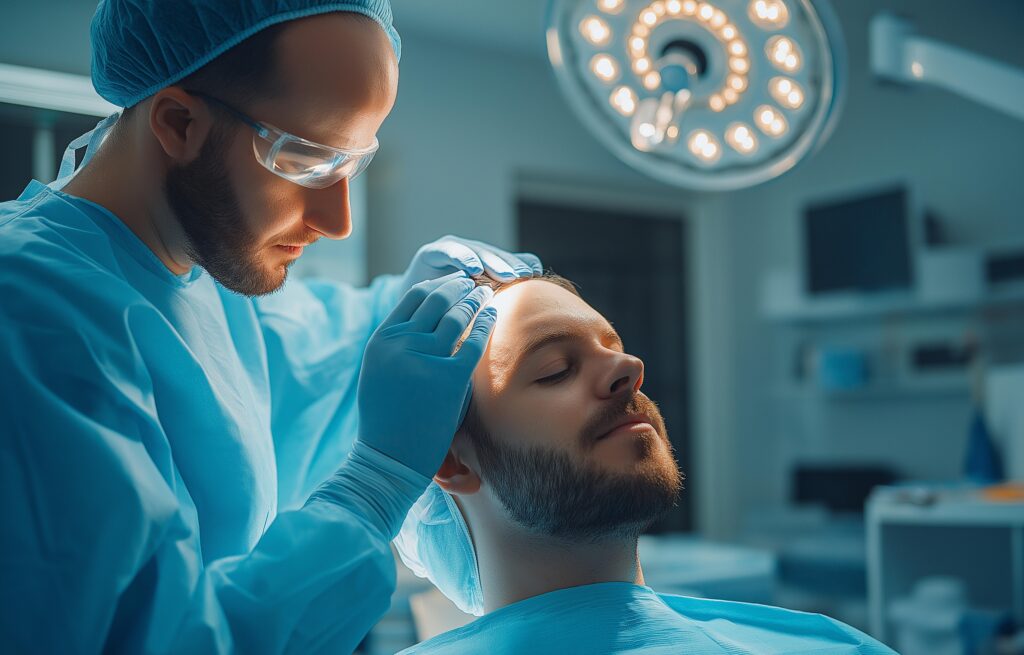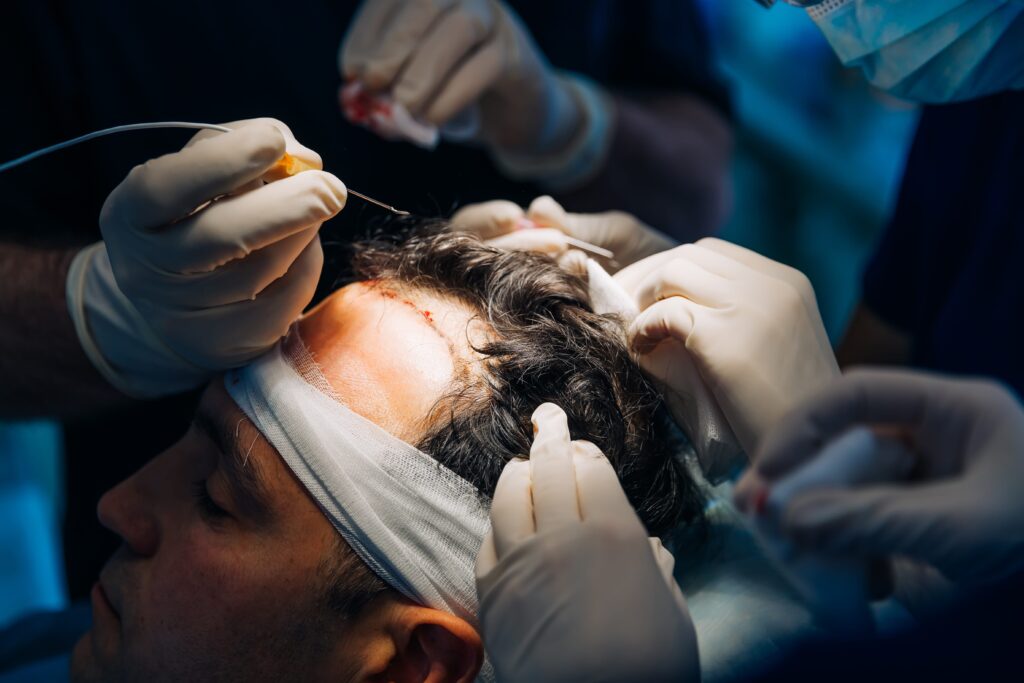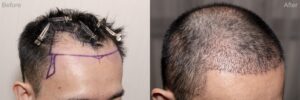Hair transplant is a revolutionizing procedure in the field of hair loss treatment. However, it can be a costly operation for many people, not to mention going under anesthesia is a source of great emotional distress. And after going through all of that, what if the results aren’t as expected? That is why it is crucial to learn about hair transplant side effects.
Understanding these side effects and knowing how to manage them is key to ensuring a long term outcome and a smooth recovery.
In this article, let’s explore the 7 things you should know about the side effects of hair transplant. It can help you prepare for the hair transplant procedure and minimize your risks.
Common Hair Transplant Side Effects

The common side effects of hair restoration procedures are usually temporary. They can subside within a few days to weeks following the procedure. However, there are some side effects that may be moderate to severe.
Mild Side Effects
Let’s look at some mild and temporary potential side effects of hair transplant that you might experience:
Swelling
One of the most common hair transplant side effects is swelling. As you recover from your procedure, you might experience some swelling around your forehead and your eyes. Due to the surgery, it takes some time for our scalp to adjust but the swelling usually subsides within 3-4 days.
Crusting and Scabbing
You may see some crusting or scabbing around your transplanted hair follicles. These scabs usually fall off on their own within 7-10 days.
Itching
You may experience some itching in your recipient and donor areas. But it’s actually a sign that your scalp is healing. So, avoid scratching that itch to prevent damage to your grafts.
Shock Loss
Hair in the donor area or the recipient area may shed a little after the procedure. This is known as shock loss. The hair typically grows back within a few months.
Moderate to Severe Side Effects
Some moderate to sever side effects include:
Infection
Without proper care after surgery, infections may occur. However, it can be treated with antibiotics.
Folliculitis
In rare cases, the hair follicles may get inflamed or infected due to trauma, sweat, oil etc. It can cause small, red pus-filled bumps. Antibiotics, warm compress and antiseptic solutions can help with this condition.
Scarring
Although rare, you may experience visible scarring after hair transplants. However, it is more common in Follicular Unit Transplantation (FUT). Practitioners at the Cosmedica Clinic do not use the FUT technique. The two methods used are the Follicular Unit Extraction (FUE) and the Direct Hair Implantation (DHI).
7 Things You Should Know About Hair Transplant Side Effects

Even though most of the hair transplant side effects are mild, you should still learn more about the side effects. Let’s take a look at 7 things you should know about the side effects of hair transplants:
1. Why Do Side Effects Happen After a Hair Transplant?
Hair transplant side effects are primarily due to the surgical nature of the procedure. Modern hair transplant involves making small incisions in donor and recipient areas. It is done to extract existing hair follicles and implant them in the desired sections. However, this process triggers the body’s natural healing responses. These responses may include swelling, inflammation, redness. Additionally, the scalp has a rich blood supply. Therefore, it can increase the likelihood of temporary bruising or swelling. However, the risks of side effects come down significantly if you are in the hands of an expert hair transplantation surgeon like Dr. Levent Acar from Cosmedica.
2. How Long Do Side Effects Last?
The duration of side effects generally depends on the expertise of your surgeon and your body’s healing mechanism. But side effects generally occur in accordance with the following timeline:
- Swelling can resolve within 3-4 days even without intervention.
- Itching can subside after 1-2 weeks.
- Crusting and scanning can clear up as the scalp heals, usually within 7-10 days.
- Shock loss can last a bit longer than swelling or itching as hair starts to regrow around the fourth month.
3. Can Hair Transplants Cause Permanent Damage or Complications?
Performed in a modern facility, with experienced surgeons, hair transplant in Turkey is one of the safest surgical procedures. The hair transplant before and after gallery at Cosmedica is a testament to that effect. However, sometimes rare complications can occur. Potential risks include:
- Excessive graft removal or overharvesting is a common term in hair transplant operation. Removal of too many hair follicles from the donor area can cause bald spots.
- Proper aftercare is very important for your transplanted hair to thrive. Poor hygiene or improper care may cause infections on your scalp and diminish your transplant results.
- FUE hair transplants usually do not exhibit much scarring compared to FUT. However, incorrect methods of surgery may lead to small white dots in the donor area.
These complications are uncommon and can be avoided by selecting a reputable clinic, like Cosmedica. The clinic employs advanced techniques like the DHI Sapphire method for precise graft placement and reduced trauma. The hair transplant costs in Turkey are comparatively affordable at Cosmedica as well.
4. How Can Aftercare Minimize Risks and Side Effects?
Hair transplant side effects can be minimized with proper aftercare. Here are some essential tips:
- Cleansing the scalp should be done very gently so as to avoid pressure in your hair follicles and prevent infection.
- Sunlight can irritate your transplanted hair follicles. Therefore, protecting the scalp from sunlight is essential after the surgery.
- The first few days after the surgery, you should sleep in a position to keep your head elevated.
- Some physical activities can sweat your scalp and increase the risk of infection. So avoid any activity that might cause sweating or put pressure on your scalp.
5. When Should I Seek Medical Attention?
Most side effects of hair transplant surgery can resolve on its own. However, you should look out for symptoms that might be worrisome. For example:
- Discharge or pustules at your surgical site.
- Persistent or recurring pain, swelling or redness beyond the normal healing time.
- Recurring or persistent fever, it could potentially indicate the presence of infection.
If you experience any of these symptoms, you should contact your surgeon to address the symptoms and avoid further complications.
6. What Can I Do If I’m Worried About Hair Transplant Side Effects?
The best way to manage hair transplant side effects is to stay informed. During your consultation, you should discuss your expectations, medical history and any concerns you might have with your doctor. It will allow you to get a sense of your procedure results in detail. Moreover, it will provide your surgeon with necessary information to personalize your procedure and post operative care.
Additionally, you should stay in contact with your clinic. This way, if any complications arise, you can receive timely advice and support.
7- How Can I Prepare for a Hair Transplant to Minimize Risks?
As with any procedure, preparation can play a significant role in minimizing postoperative issues. Here’s how you can prepare:
Choose an Experienced Surgeon and Clinic
Your choice of clinic and surgeon is the most crucial decision you will make in your hair transplant journey. So, research a clinic with good reviews and modern facilities that provides the latest hair transplant techniques. Dr. Levant Acar of Cosmedica specializes in the Micro Sapphire DHI method to enhance results and minimize scarring.
Follow Preoperative Guidelines
Follow your surgeon’s advice. Avoid smoking, alcohol, certain medications and take the essential hair nutrients like the Hair Power Booster Pack for optimal hair growth.
Set Realistic Expectations
Hair transplants can be a permanent solution for hair loss, but it is also a lengthy process. The implanted hair grafts take time to grow. Even if the surgery is successful, not all transplants will regrow. So, understanding the process of hair transplant might help improve satisfaction and reduce anxiety.
Final Remarks
Any surgical procedure will come with its own set of complications. A hair transplant is no different. However, the hair transplant side effects can be managed. Especially if you choose an experienced surgeon.
At Cosmedica Clinic, Dr. Levent Acar and his team are dedicated to providing cutting-edge technology for natural, long-lasting results. If you’re considering a hair transplant, visit the Cosmedica website to book a free consultation and take the first step of your journey.




